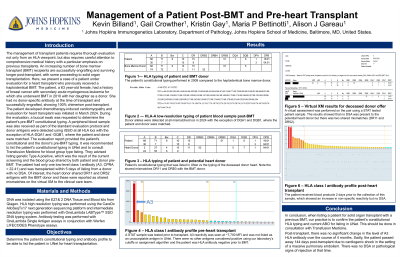Back

(P804) Management of a patient post-BMT and pre-heart transplant
Location: Platinum Ballroom

- KB
Poster Presenter(s)
Body: The management of transplant patients requires thorough evaluation not only from an HLA viewpoint, but also requires careful attention to comprehensive medical history with a particular emphasis on previous transplants. An increasing number of bone marrow transplant (BMT) recipients are successfully engrafting and surviving longer post-transplant, with some proceeding to solid organ transplantation. Here, we present a case of a patient under evaluation for a heart transplant who previously received a haploidentical BMT. The patient, a 63 year-old female, had a history of breast cancer with secondary acute myelogenous leukemia for which she underwent BMT in 2010 with her daughter as a donor. She had no donor-specific antibody at the time of transplant and successfully engrafted, showing 100% chimerism post-transplant. The patient developed chemotherapy-induced cardiomyopathy and evaluation for heart transplant was initiated in March 2024. During the evaluation, a buccal swab was requested to determine the patient’s pre-BMT constitutional typing. A peripheral blood sample was also received as part of the standard evaluation protocol and donor antigens were detected using rSSO at all HLA loci with the exception of HLA-DQA1 and -DQB1, where the patient and donor were matched. The evaluation report provided the patient’s constitutional and the donor’s pre-BMT typing. It was recommended to list the patient’s constitutional typing in UNet and to consult Transfusion Medicine for blood group type listing. They advised listing genetic Type A positive, which was the result of the current screening and the blood group shared by both patient and donor pre-BMT. The patient had only one low-level class I antibody (A3, CPRA = 22.41) and was transplanted within 5 days of listing from a donor with no DSA. Of interest, the heart donor shared DR11 and DR52 antigens with the BMT donor and these were reported as shared mismatches on the virtual XM to the clinical care team. To date, the patient remains stable, with good clinical function and no evidence of donor-specific antibody.
Conclusion: In conclusion, when listing a patient for solid organ transplant with a previous BMT, our practice is to confirm the patient’s constitutional HLA typing and current ABO for listing in UNet.
Conclusion: In conclusion, when listing a patient for solid organ transplant with a previous BMT, our practice is to confirm the patient’s constitutional HLA typing and current ABO for listing in UNet.
